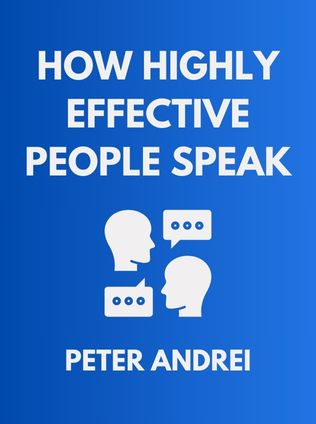
How Highly Effective People Speak
How High Performers Use Psychology to Influence With Ease (Speak for Success Book 1)
By Peter Andrei
Published 05/2020
About the Author
Peter D. Andrei, the author of How Highly Effective People Speak, is a communication expert who delves deep into the art and science of persuasive speaking. His background is rooted in both practical experience and academic research, allowing him to bring a unique perspective to the subject of effective communication. Andrei’s work stands out because he doesn’t just regurgitate common advice on public speaking; instead, he provides a comprehensive framework based on cognitive biases and psychological principles, offering readers a profound understanding of why certain communication strategies work.
Main Idea
In How Highly Effective People Speak, Andrei posits that effective communication is not merely about charisma or natural talent; rather, it’s a skill that can be mastered through understanding and applying the principles of cognitive biases. These biases are ingrained patterns of thought that can be leveraged to make communication more compelling and persuasive. Andrei argues that by understanding these biases, anyone can learn to speak in a way that resonates with their audience, whether they’re delivering a speech, writing an email, or engaging in everyday conversations.
Table of Contents
- Introduction to Effective Communication
- The Morality of Rhetoric
- Availability Bias: The Power of What Comes to Mind
- Narrative Bias: The Persuasive Power of Stories
- Simplicity: The Strength of a Clear Message
- Imagery: Making Your Message Visual
- Attribute Substitution: Emotional Persuasion
- Social Proof: The Influence of Others
- Anchoring Bias: Setting the Stage
- Zero-Risk Bias: The Appeal of Safety
- The Halo Effect: First Impressions Matter
- Contrast Effect: Power of Comparisons
- Conclusion: Mastering the Art of Persuasive Communication
Introduction to Effective Communication
Effective communication is often misunderstood as a natural talent that only a few possess. However, as Andrei asserts, communication is more of a science than an art, grounded in principles that can be studied, learned, and mastered. The book challenges the notion that good communication is about being charismatic or eloquent; instead, it emphasizes the importance of understanding how human cognition works and how this knowledge can be applied to improve communication skills.
The Morality of Rhetoric
One of the first issues Andrei tackles is the morality of rhetoric. He acknowledges that persuasion can be a double-edged sword, capable of being used for both ethical and unethical purposes. The key, he argues, lies in the speaker’s intentions. If the goal of persuasion is to lead others toward truth or beneficial outcomes, then employing rhetorical techniques is not only acceptable but also necessary. Andrei emphasizes that understanding cognitive biases isn’t about manipulating others but about communicating in a way that aligns with how people naturally process information.
"Rhetoric is a tool you should understand how to use not for selfish or unethical reasons, but so you can persuade others according to your moral standards." – Peter D. Andrei
Availability Bias: The Power of What Comes to Mind
Andrei begins his exploration of cognitive biases with the availability bias, which refers to the human tendency to give more weight to information that comes easily to mind. This bias can be a powerful tool in communication because it allows speakers to make their message more memorable by focusing on vivid, emotionally charged, or frequently mentioned examples.
For instance, when people hear about plane crashes, they often overestimate the likelihood of such events simply because these incidents are reported more frequently in the media, making them more available in memory. Andrei suggests that effective communicators can harness this bias by making their key points emotionally vivid and easy to recall.
Consider the following example of availability bias in action:
- A politician emphasizes a rare but highly publicized crime to argue for stricter laws, even if statistically, crime rates are declining.
- A company highlights a dramatic success story of a customer using their product, making it seem like a common experience.
- A public speaker uses a shocking statistic to anchor the audience's perception of a broader issue.
By understanding and using the availability bias, communicators can ensure their message is the one that sticks in the minds of their audience long after the conversation has ended.
Sign up for FREE and get access to 1,400+ books summaries.
You May Also Like
The Subtle Art of Not Giving a F*ck
A Counterintuitive Approach to Living a Good Life
By Mark MansonRich Dad Poor Dad
What the Rich Teach Their Kids About Money - That the Poor and Middle Class Do Not!
By Robert T. KiyosakiHow To Win Friends and Influence People
The All-Time Classic Manual Of People Skills
By Dale CarnegieFreakonomics
A Rogue Economist Explores the Hidden Side of Everything
By Steven D. Levitt and Stephen J. Dubner



















